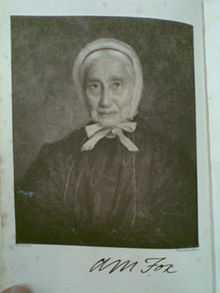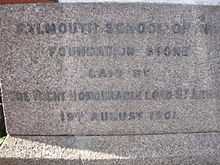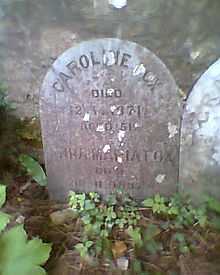Anna Maria Fox
Anna Maria Fox (21 February 1816[1] – 18 November 1897[2]) was a promoter of the Royal Cornwall Polytechnic Society and the artistic and cultural development of Falmouth in Cornwall, UK.
Family links
Anna Maria Fox was the eldest child of Robert Were Fox FRS (26 April 1789 – 25 July 1877) and Maria Barclay (1785–1858), his wife.
Her father was a member of the Quaker Fox family of Falmouth and her mother of the Quaker Barclay family of Bury Hill, near Dorking. Her maternal grandmother was a first cousin of Elizabeth Fry.
Her siblings were Barclay Fox (6 September 1817 – 10 March 1855) and Caroline Fox (24 May 1819 – 12 January 1871). The family lived at Rosehill [3] and Penjerrick
She never married. With her sister, Caroline, she raised the four sons of her brother, Barclay, after the death of their parents.
Anna Maria outlived her sister by sixteen years, which Thomas Hodgkin [4] described as a "widowhood". She died, aged 81 on 18 November 1897 and was buried at the Quaker Burial Ground in Budock, in the same plot as her sister, Caroline[5]
The Journals
In their teenage years, Robert Were Fox challenged his children to keep journals, offering a guinea reward for the first year completed. All three kept journals for many years.
Anna Maria commissioned a relative by marriage, Horace Pym, to edit and publish her sister's journal. The book Memories of old friends was published by Smith, Elder & Co. ten year's after Caroline Fox's death. It sold well. Before her death, Anna Maria arranged for all the original volumes of Caroline's journals to be burnt. A further selection from Memories of old friends, edited by Wendy Monk, was published in 1972.
Barclay Fox's journal, edited by Raymond Brett, was published in 1979.[6]
Anna Maria gave instructions that "no word of my journal is to be published".[4]
.jpg)
Royal Cornwall Polytechnic Society
The idea for the foundation of the Royal Cornwall Polytechnic Society was created by Anna Maria, Barclay and Caroline Fox, in 1832, when they were 17, 16 and 13, respectively. Their parents, uncles and aunts and their friends took up the idea with enthusiasm.
In 1896, Anna Maria Fox was elected as Vice-Patroness of the Poly, sharing this role with the Prince of Wales.[7]
The Poly in Church Street, Falmouth hit serious financial problems in January 2010 and closed its commercial arm.
From the Royal Cornwall Polytechnic Society Annual Report for 1897:
"ANNA MARIA FOX
The Annual Report of the Royal Cornwall Polytechnic Society for 1897 will be distinguished from its predecessors by one element of deep, but melancholy interest.
The duty devolves upon us of recording the death of the venerable lady who was its virtual founder, and who has outlived all that noble band of patriotic Cornishmen and, Cornishwomen, who helped her to make her dream a reality. ..."Robert W. Fox FRS
"Miss Fox's father was a man of high scientific attainment, as is sufficiently shown by his having been elected a Fellow of the Royal Society, an honour which has not been too lavishly conferred on those labourers in the scientific field who have lived at a distance from London. Mr. Fox's special attention was devoted to the science of magnetism. He invented the deflector dipping needle, which has been so largely used in Arctic and Antarctic Expeditions since that time. He made some valuable discoveries in the relation between magnetic currents and the deposit of minerals. By observations extending over 40 years he proved that there was a real increase of temperature in descending through the earth's crust, a fact long disputed by Humboldt until Fox's experiments led him to accept his hypothesis."
Anna Maria's suggestion
"His keen interest in science brought him into contact with many of the most eminent geologists and mineralogists of his time, and the conversation and correspondence of these men undoubtedly inspired his daughter with some of their enthusiasm for scientific pursuits. But it was not a merely scientific interest which caused Miss Fox while still in her girlhood to suggest to her father and his friends, the foundation of the Cornwall Polytechnic Society. In this enterprise, as in so many others, which were promoted by her in the course of a long and useful life there was, an element of practical benevolence and of sympathy with the struggles and aspirations of those who are born to an inheritance of toil."
Foundrymen's inventions
"For several years between 1820 and 1860, the iron foundry of Perran was partly owned by members of the Fox family and the workmen of the foundry, who appear to have been a superior class of men, even for Cornwall, frequently, brought models of machines and other inventions to her father for the benefit his advice and opinion, The thought suggested itself to Miss Fox, “What an advantage it would be to those men if there could be some fitting arena provided for all this inventive talent: if the really useful inventions could be at once recognised and rewarded, and if those clever men who are only wasting their time by trying to do something which has already been done, and has proved useless, could by conference with more experienced mechanicians be saved from thus squandering their energies!"
The idea of the Poly
"This was the kind of scheme which appealed to the mind of Anna Maria Fox, then a girl of only 17 years of age, and which was warmly approved by her father. It must be remembered to the honour of some of Miss Fox's Cornish neighbours that they too saw the merits of her suggestion , and that no discouraging reflections on the youth and inexperience of the proposer prevented them from adoption and carrying it to a successful issue. In this connection the names of Lord de Dunstanville, Sir Charles Lemon Bart., M.P., Mr. Davies Gilbert, P.R.S., Mr. John S. Enys, as well as those of Miss Fox's uncles, Mr. George Croker Fox and Mr. Charles Fox, deserve special mention."
Anna Maria Fox's contribution and diligent support
"Thus then, 64 years ago, was founded “The Polytechnic” of Cornwall, its name being suggested by Miss Fox's younger sister Caroline, who no doubt borrowed it from the great École Polytechnique of Paris. Since that time the story of the Polytechnic and its founder have been almost inseparably intertwined. There have hardly been any of our Annual Meetings at which she has not been present. In middle life and on into old age her unquenched enthusiasm has been manifested in forwarding our work. It should, perhaps, be observed that it was chiefly owing to Miss Fox's influence that the artistic side of the Polytechnic Society's work received from the first such careful attention. At the time of its foundation, Art Education had received but inadequate recognition, and there was a certain tendency in those who concerned themselves with popular education to over-value physical science, and to lightly regard those studies, whether in Literature or Art - which concerned themselves with the Beautiful rather than the Useful: Miss Fox (who was herself an Artist of no mean order, as well as an eager student of science) had wider sympathies, and successfully guided the Institution which she had founded into that career, artistic as well as scientific, which it has ever since pursued. In this connection we may mention one of the best known and most striking of her pictures, painted in 1863: a study of the tossing waves of the Bay of Biscay, taken from the saloon of a Steamer in circumstances which would to most persons have made all thought of sketching impossible. But many other productions of her boldly handled brush have adorned our walls at the time of our annual Exhibitions."
The Tuke portrait

"The Society may congratulate itself and the foresight which, while she was still amongst us procured the admirable portrait of Miss Fox, from the hand of Mr. H. S. Tuke, of Falmouth, a photogravure of a which forms a frontispiece to this Report."
Scientific and cultural friends
"Owing to her father's high position in the scientific world, Miss Fox was for the greater part of her life in frequent intercourse with eminent men of science. Sir Henry T. De la Beche, Dr. Lloyd, Provost of Trinity College, Dublin,[8] Dr. Whewell, Master of Trinity College, Cambridge, Prof. Airy, Rev. Prof. Sedgwick, Dr. Gladstone, Prof. J. Couch Adams, Prof. Wheatstone, Prof. Richard Owen, Lord Rosse, Sir Edward Sabine, Sir Charles Lyell, Arago, Sir Wm. Hooker and other men well known in the world of science were among her friends, as well as poets and philosophers - men, like Wordsworth, Derwent Coleridge, Charles Kingsley, Frederick Maurice, Guizot, Chevalier Bunsen,[9] John Stuart Mill, John Sterling and Thomas Carlyle, some of whose conversations are recorded in the posthumously published journals of her sister, Caroline Fox. All who were thus brought into contact with her were struck by her keen interest in the results of modern scientific investigation, and her alertness in grasping the leading features of recent discoveries. An original worker in any branch of science she never was, nor aspired to be, but having been from childhood much in the company of earnest and successful students of the book of Nature, she entered heartily into their enthusiasms, and pursued her own individual course of study sufficiently far to enable her to understand something of the language in which they spoke."
Miss Fox's other interests
"Of other aspects of Miss Fox's marvellously active and useful life, this is not the place to speak, except in the way of the briefest allusion. The British School, The Royal Cornwall Sailors' Home, The Falmouth Coffee Tavern [10] on the Quay; The Convalescent Home at Penjerrick Garden, and many similar undertakings all testified: her earnest desire to benefit her fellow creatures, and especially to help those who were less fortunately placed than herself. All who knew her could see that a deep and strong religious faith was the mainspring of her life's activities, yet bigotry and ascetic gloom found no place in her sunny and joyous character."
Love and veneration
"She died at Penjerrick, a charming country seat of the family, near Falmouth, after a very short illness, on 18 November 1897, in the 82nd year of her age, leaving behind her a name which will long be loved and venerated in Cornwall, and especially by the Royal Cornwall Polytechnic Society."
Painting and Art Education
She was a good amateur painter and organised of the Art section of the Annual Exhibition at the "Poly". The Cornwall Art Union was formed in 1852, associated with the Poly.[11] Art classes run by the Poly were a precursor of the Falmouth School of Art.
The first purpose-built building of the School, in Arwenack Street, was given in memory of Anna Maria Fox.[12] The building, officially opened in August 1902 was refurbished in 2007.
Gallery: Falmouth School of Art's first building
-

Falmouth School of Art - original building opened in August 1902.
-

Falmouth School of Art - original building - Entrance.
-

Falmouth School of Art - original building - Foundation stone 1901.
Gallery: Wellington Terrace Primary School building
-

Foundation stone "laid by Miss A. M. Fox of Penjerrick 22 June 1897".
-

View of building, now owned by University College of Falmouth.
Pets and personality
She kept a variety of exotic pets - including marmosets, parriquets, love-birds, cockatiels, canaries and avadavats. Thomas Hodgkin notes that whilst her sister Caroline was prone to sarcasm, Anna Maria always had an optimistic and less critical attitude to other people.[4]
Travels
Robert Were Fox usually took his children on his journeys out of Cornwall. The family often attended the annual Quaker gathering in London, held in May, and met their relations and friends. Robert also took them the meetings of the British Association, held in towns around the United Kingdom and Ireland. In 1880, she visited Palestine [4] In August, 1884, she visited Canada and the US, with her nephew, Howard Fox, to attend the British Association meeting in Montreal and the meeting of the BAAS with the American Association in Philadelphia, organised by Lord Rayleigh.[13]
Likenesses
The portrait of Anna Maria Fox by Henry Scott Tuke, reproduced in the 1897 Poly Annual Report, is currently on display at the Falmouth Gallery, in the Moor (28/06/2012). A photograph of Tuke painting Anna Maria is at the Tate Gallery.[14] In Old Falmouth Miss Susan Gay reproduces a full length photographic portrait "at Penjerrick Garden", opposite page 15.

Sources and references
Sources
The Journals
- Fox, Caroline (1881) Memories of Old Friends: Caroline Fox of Penjerrick, Cornwall (edited by H. N. Pym, 1881; 2nd edition, 1882).
- Fox, Caroline (1972). The journals of Caroline Fox, 1835–1871: a selection, edited by Wendy Monk. London: Paul Elek. ISBN 0-236-15447-8.
- Fox, Robert Barclay (1979). Barclay Fox's journal, (edited by Raymond Brett). London: Bell and Hyman. ISBN 0-7135-1865-0. U.S. edition, Rowman & Littlefield (1979), Totowa, N.J. ISBN 0-8476-6187-3
Other Sources
- Gay, Susan E. (1903) Old Falmouth: the story of the town from the days of the Killigrews to the earliest part of the Nineteenth century, London, Headley Brothers.
- Harris, Wilson (1944). Caroline Fox. London: Constable..[15]
- Hodgkin, Thomas (1898) "Anna Maria Fox", Friends Quarterly Examiner, Vol. CXXV, 1st month 1898. pp. 115–136.
- Royal Cornwall Polytechnic Society Annual Report for 1897, pp. v-ix Obituary of Anna Maria Fox. A photogravure of her full-face portrait by Henry Scott Tuke forms the frontispiece.
- Tod, Robert (1978). Caroline Fox, Quaker bluestocking: 1819-1871. York: William Sessions Limited. ISBN 0-900657-54-5.
- 'Dictionary of Quaker Biography': Huge typescript resource at the Library of the Religious Society of Friends, Euston, London UK, known as "DQB".
References
- ↑ Barclay Fox's journal. See Sources above for bibliographical details.
- ↑ 'DQB' See Sources above.
- ↑ Carrick District Council description of Rosehill garden (accessed 18 November 2007).
- ↑ 4.0 4.1 4.2 4.3 Biographical article in Friends Quarterly Examiner,1898. Bibliographic details in Sources, above.
- ↑ Cornwall Record Office Document ADD447: Blueprint plan of the Burial Ground. Caroline and Anna Maria Fox were buried in Plot 90.
- ↑ Bibliographical details of these books given above, under Sources
- ↑ The role of Vice-Patroness is listed in the Poly's Annual Report, 1896.
- ↑ Biography of Bartholomew Lloyd onTCD website
- ↑ Chevalier Bunsen = Ernest de Bunsen, son of Christian Charles Josias von Bunsen.
- ↑ This is thought to be a Temperance venture, similar to the Coffee Tavern in Plymouth.
- ↑ Miss Susan Gay's Falmouth chronology
- ↑ Gay, Susan E. Old Falmouth page 238 Bibliographic details in Sources, above.
- ↑ Gutenberg text Lady Rayleigh's Account of travel to Montreal (Accessed 9 December 2007): Clara, Lady Rayleigh's account of travel to the British Association for the Advancement of Science Meetings in Canada and America in August 1884:
Sunday, 24 August: "However, the sun broke forth and lifted the curtain of fog, and within a quarter of a mile we saw a beautiful iceberg twelve or fifteen hundred feet deep, they said, and so beautiful in its ultra marine colouring. The shape was like a village church somewhat in ruins. Miss Fox, a sister of Caroline Fox, is on board and sketched the icebergs and the waves during the storm very cleverly." . . .
"A scientific man asked questions as to whether we could prove answers to prayer would be given for physical blessings, or what we consider such; or whether prayer was only a sentiment (as Tyndal thinks)? Professor Barrett and a dear old clergyman, Canon Rogers (who, in my ignorance, I had thought, at first, was a "dry stick") argued the matter with him, and also Dr. P. Smith and his son, and Miss Fox and I said a few words. Now, about nine o'clock, they are all singing hymns, very much out of tune. I must finish this up now for it must be posted to-morrow, or may miss the mail on Tuesday. I have thoroughly enjoyed the last three days, and am almost sorry the voyage is over, and so, I think, are many of my fellow passengers. Some of them are very good and nice. Miss Fox is delightful--upwards of eighty, and yet so full of interest in everything good and beautiful; she is like a piece cut out of the old past, and a very wonderful old fossil, full of energy and cleverness." (Clara, Lady Rayleigh was the mother of Lord Rayleigh, (President of the BAAS), whom she accompanied in this journey).
- ↑ The personal papers of Thomas Cooper Gotch (1854-1931) and Henry Scott Tuke:TGA 9019/1/4/2- Photograph of Henry Scott Tuke painting Anna Maria Fox in the garden at Penjerrick (accessed 8 November 2007).
- ↑ (Henry) Wilson Harris (1883–1955), journalist and author (Biographer of Caroline Fox), is the subject of an article in ODNB: Derek Hudson, ‘Harris, (Henry) Wilson (1883–1955)’, rev. Marc Brodie, Oxford Dictionary of National Biography, Oxford University Press, 2004 , accessed 10 Dec 2007. His parents were Plymouth Quakers.